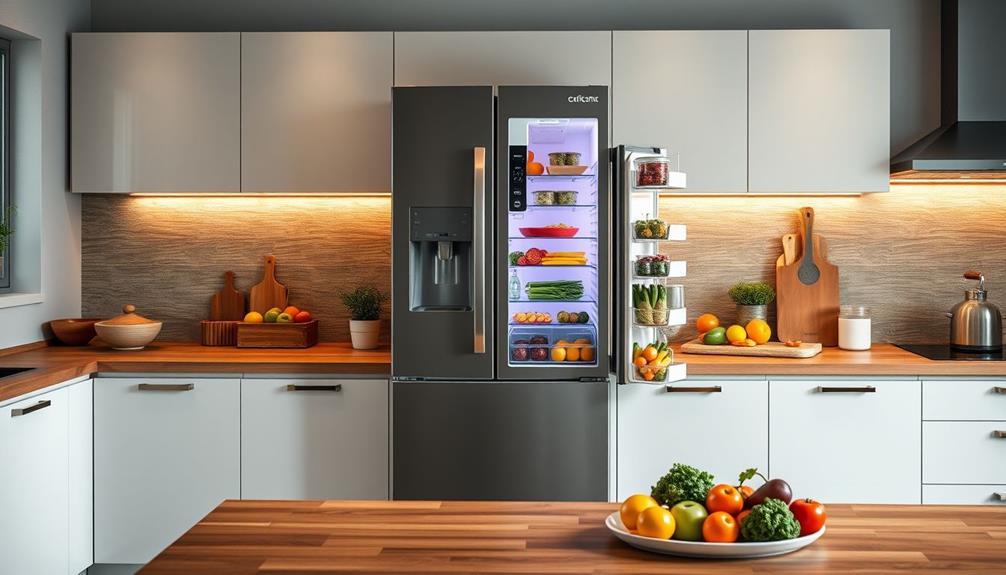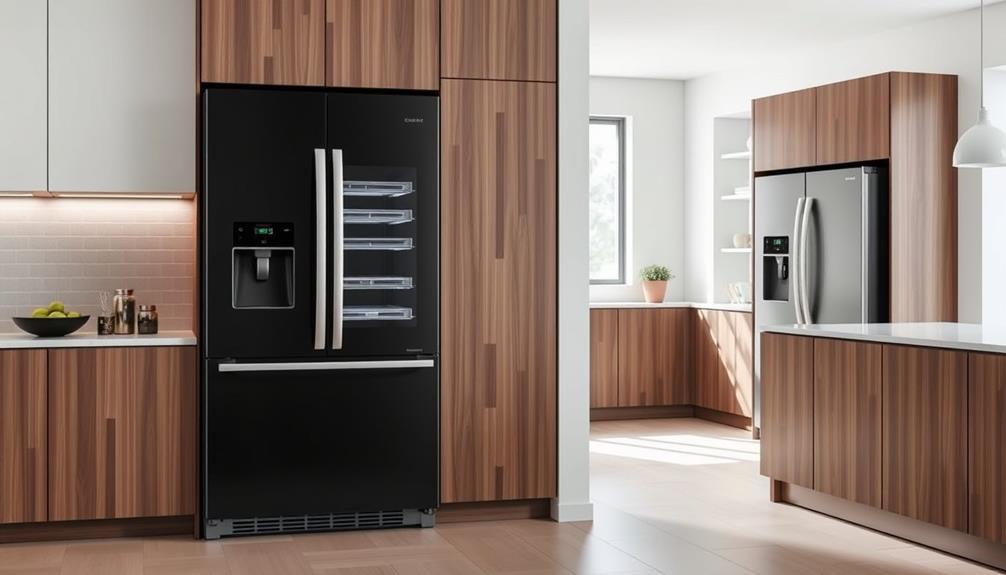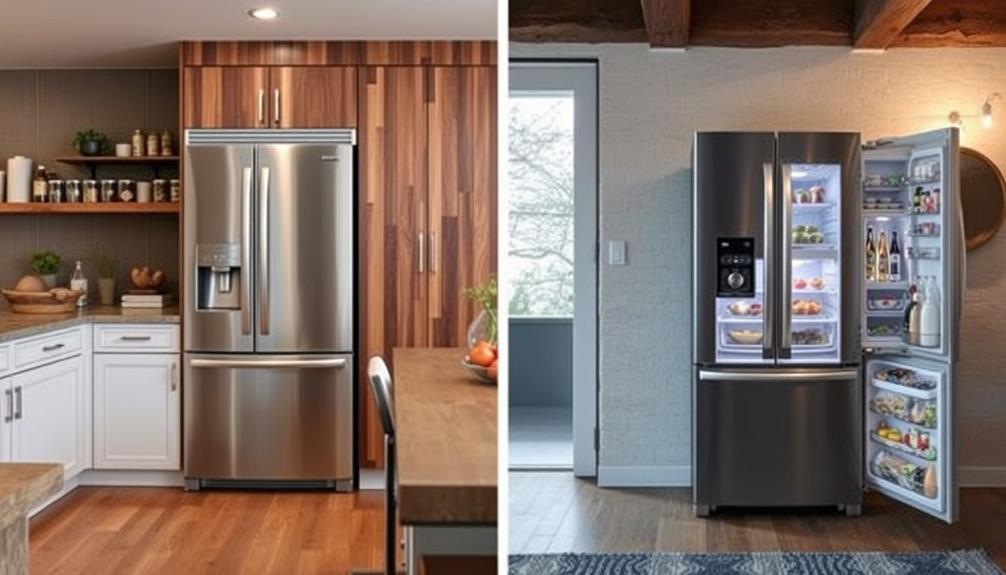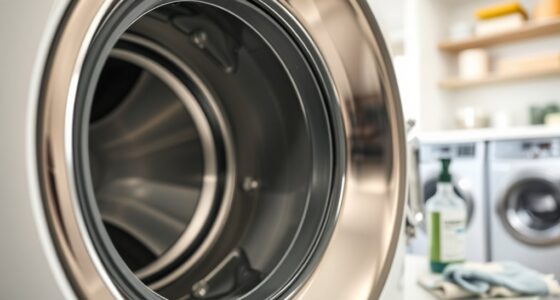When you are faced with the decision between built-in and freestanding refrigerators, consider your priorities. Built-in models offer a high-end, cohesive appearance and larger storage capacity, but they also come with a higher cost and require professional installation. On the other hand, freestanding refrigerators are more affordable, simple to install, and flexible in terms of placement. However, they may not seamlessly blend into your kitchen design and typically have less storage space. Take into account your available space, aesthetic preferences, and budget in order to choose the best option for your needs. There are many factors to consider to ensure you make an informed decision.
Key Takeaways
- Built-in refrigerators offer a premium aesthetic and seamless integration with cabinetry, enhancing kitchen design and increasing home value.
- Freestanding refrigerators provide flexible placement options and a variety of styles at a more affordable price point.
- Built-in models generally have larger capacities, making them suitable for big families and bulk shopping needs.
- Installation of built-in refrigerators is complex and requires professionals, while freestanding models are easy to set up and relocate.
- Freestanding refrigerators may protrude, impacting kitchen space, and often have variable quality compared to the more durable built-in options.
Overview of Built-In Refrigerators
When you're looking to elevate your kitchen's style, built-in refrigerators stand out as a seamless solution. Designed for seamless integration into your cabinetry, these appliances create a high-end aesthetic that enhances your overall kitchen design.
Typically taller than freestanding models, they often exceed 80 inches in height and can be up to 48 inches wide. With a cabinet depth of around 24 inches, built-in refrigerators offer a more streamlined appearance, making them shallower than their freestanding counterparts. Incorporating a modern farmhouse design can further elevate the look of your kitchen while complementing the functionality of a built-in fridge.
Opting for a built-in fridge means you'll enjoy a premium look, perfect for those who appreciate sophisticated design. However, keep in mind that these models usually require professional installation due to their complexity and the precise measurements needed to fit your existing cabinetry.
While built-in refrigerators offer larger capacities suitable for big families, they come at a notably higher price point, typically starting around $5,000. If you're looking to invest in a kitchen upgrade that combines style and functionality, a built-in refrigerator might be the perfect choice for you.
Overview of Freestanding Refrigerators

Freestanding refrigerators offer you flexible placement options, allowing them to fit seamlessly into various kitchen layouts.
With a range of styles and configurations, these units cater to different needs without breaking the bank.
Additionally, many freestanding models come equipped with advanced features and energy-efficient designs, making them a smart choice for the environmentally conscious homeowner.
For those considering a thorough cleaning of their kitchen appliances, essential items for a home cleaning kit can enhance your maintenance routine.
Plus, their budget-friendly price points make them an appealing choice for most homeowners.
Versatile Placement Options
Flexibility is a key advantage of freestanding refrigerators, allowing you to place them anywhere in your kitchen as long as there's an electrical outlet nearby. This versatility in placement options means you can easily adapt your kitchen design to meet your needs.
Whether you prefer a top freezer, bottom freezer, side-by-side, or French door configuration, freestanding refrigerators offer a variety of styles to suit your taste and space. Regular maintenance and awareness of cat health and nutrition can also guarantee that any food stored remains safe for your pets, particularly if they're curious about the kitchen.
One benefit of these models is their maximum width of 36 inches, which fits comfortably in different kitchen sizes without requiring custom cabinetry. When you decide to update your kitchen or relocate, installing a freestanding refrigerator is straightforward. You can simply slide it into place without needing professional help or specialized tools.
Unlike built-in fridges that are fixed in one spot, freestanding refrigerators can easily be moved. This feature is perfect for those who enjoy rearranging their kitchen layout or may need to relocate in the future.
With this flexibility, you can keep your kitchen functional and stylish, adapting as your needs change over time.
Budget-Friendly Choices
For those looking to update their kitchen without breaking the bank, freestanding refrigerators offer a budget-friendly solution. Starting around $400 and often costing less than $2,000, these models make it easy to find something that fits your financial plan.
With various configurations—like top freezer, bottom freezer, side-by-side, and French doors—you can select a design that complements your kitchen layout and meets your preferences. Additionally, many freestanding refrigerators are energy-efficient, helping to minimize energy consumption of appliances and reduce utility bills over time.
Freestanding refrigerators come in both full depth and counter-depth options, giving you the choice between maximizing storage space or achieving a sleek, flush look with your countertops. Unlike built-in models, they don't require professional installation, which simplifies the setup process and helps you save on initial costs.
The wide range of styles and sizes available means you can discover an affordable freestanding refrigerator that aligns perfectly with your kitchen design needs.
Whether you prioritize functionality or aesthetics, you're likely to find a model that strikes the right balance without stretching your budget. By choosing a freestanding refrigerator, you can enjoy modern features and style while keeping costs manageable.
Pros and Cons of Built-In Refrigerators

When considering a kitchen upgrade, built-in refrigerators stand out for their premium aesthetic and seamless integration with cabinetry. These models enhance the overall design of high-end kitchens, making them a popular choice for homeowners. However, they come with both advantages and disadvantages.
| Pros | Cons | Considerations |
|---|---|---|
| Premium aesthetic | Higher cost (50%+ than freestanding models) | Budget implications |
| Seamless integration | Installation complexity requiring professionals | Time and effort for setup |
| Larger storage capacity | Limited space for large items due to shallower depth | Consider your storage needs |
| Designed for permanence | Less flexibility in relocation | Future kitchen redesigns |
Built-in refrigerators typically feature widths up to 48 inches and heights over 80 inches, providing ample storage for families or bulk shopping. They fit flush with your cabinets, enhancing visual appeal. However, their installation complexity can add to the overall cost, and you'll need to think about how relocating them might be difficult. Weighing the pros and cons will help you determine if a built-in model is the right fit for your kitchen upgrade.
Pros and Cons of Freestanding Refrigerators

Freestanding refrigerators offer a practical solution for homeowners seeking affordability and variety. These models typically start around $400, making them budget-friendly options for most households.
They come in various styles, allowing you to choose one that fits your kitchen design. Additionally, just as selecting the right dog breed can greatly impact your home life, choosing a refrigerator that complements your kitchen is essential for overall functionality and aesthetics unique Akita names for exotic breeds.
Here are some key pros and cons to evaluate:
- Affordable: Freestanding refrigerators are generally less expensive than built-in models.
- Flexibility: With styles like top freezer, bottom freezer, side-by-side, and French doors, you can find a model that suits your needs.
- Easy Installation: You won't need professional help for installation, making it simple to set up and relocate if necessary.
- Protrusion: Keep in mind that these units can protrude more than six inches beyond countertops, which might impact space utilization in smaller kitchens.
While freestanding refrigerators provide great options regarding price and styles, reflect on how their protrusion might affect your kitchen's look and functionality.
Key Comparisons Between Types

When choosing between built-in and freestanding refrigerators, consider how each option fits your kitchen's aesthetic and your budget.
Built-ins offer seamless integration but come with a higher price tag and installation complexity. Additionally, built-in models often provide more efficient energy use, which can be beneficial for long-term savings, while freestanding options allow for easier access to features like garage door openers.
On the other hand, freestanding models are more affordable and easier to set up, giving you flexibility in placement.
Aesthetic Integration Options
Creating a harmonious kitchen environment often hinges on the choice between built-in and freestanding refrigerators. Built-in refrigerators offer a flush appearance that seamlessly integrates into your cabinetry, enhancing high-end kitchen aesthetics. They allow for custom panel fronts that can match your cabinetry, providing a cohesive look that elevates your kitchen's design.
Additionally, many modern kitchens feature appliances that prioritize functionality, just like budget-friendly vacuums that offer efficiency without breaking the bank.
On the other hand, freestanding refrigerators, while versatile and available in various styles, often have limited color choices and can protrude beyond cabinetry. This affects their visual integration, making them less suitable for a seamless aesthetic.
Here are some key considerations:
- Flush Appearance: Built-ins create a sleek, integrated look.
- Custom Panel Fronts: Built-ins allow for personalized designs that match cabinetry.
- Installation Complexity: Built-ins require professional installation for proper alignment, while freestanding models are easier to place.
- Space Suitability: Freestanding refrigerators can appear bulkier in smaller kitchens, impacting overall aesthetics.
Ultimately, your choice will depend on the desired aesthetic integration and how you envision your kitchen's overall look. Choose wisely to achieve the kitchen of your dreams!
Cost and Budgeting Considerations
Choosing between built-in and freestanding refrigerators also involves considerable financial implications. Built-in refrigerators typically start at around $5,000, which is about 50% more than freestanding models that can begin as low as $400. The higher initial cost of built-ins often includes professional installation fees, adding several hundred dollars to your overall expense. In contrast, freestanding refrigerators provide a broader range of budget-friendly options, with many available for under $2,000, making them more accessible for average consumers.
Here's a quick comparison:
| Refrigerator Type | Initial Cost Range |
|---|---|
| Built-In Refrigerators | $5,000 and up |
| Freestanding Refrigerators | $400 – $2,000 |
While built-in models generally offer a higher resale value, appealing to buyers looking for high-end aesthetics, they do require careful budgeting. Furthermore, planning a kitchen renovation can increase costs considerably for built-ins due to necessary cabinetry adjustments, unlike freestanding models, which typically demand less planning and expense. As a result, weighing your budget against your preferences is essential when making your decision.
Installation Complexity Factors
The installation complexity of refrigerators can considerably influence your decision between built-in and freestanding models. If you're weighing your options, consider these key factors:
1. Professional Help: Built-in refrigerators often require professional installation because of their complexity and the need for precise cabinetry measurements. Freestanding models can be set up easily without specialized assistance, making them a preferred choice for those seeking immediate functionality and ease of use.
Clogging Remedies can also be a concern if your refrigerator is situated near plumbing.
2. Cabinetry Adjustments: Installing a built-in fridge usually involves custom cabinetry and plumbing modifications, leading to increased time and labor costs.
In contrast, freestanding refrigerators offer a straightforward plug-and-play setup, which can save both time and money during installation.
3. Space Considerations: Built-in units are designed to fit flush with cabinetry, which may limit your kitchen layout flexibility.
Freestanding refrigerators, however, can be placed anywhere with access to an electrical outlet, allowing for greater design freedom.
4. Maintenance and Relocation: Built-in models can take longer to install and are less portable, while freestanding refrigerators can be relocated in minutes if necessary, simplifying maintenance and repairs.
Knowing these installation complexity factors will help you choose the right refrigerator that fits your lifestyle and kitchen design.
Choosing the Right Refrigerator

When it comes to selecting the right refrigerator, your kitchen design plays a crucial role in the decision-making process. You'll need to choose between built-in and freestanding models based on your space and aesthetic preferences.
Built-in refrigerators offer a seamless integration for a high-end look, while freestanding units provide flexibility in placement and style options. Additionally, consider how your choice may impact your financial planning for the future, as investing in high-quality appliances can be part of a broader strategy to enhance your home's value, akin to the benefits of diversification in retirement portfolios.
Consider your storage needs as well. Freestanding models typically have greater capacity due to their deeper design, which can be a significant advantage if you have a larger household or frequently entertain.
On the other hand, built-ins may have a shallower depth of around 24 inches, limiting their storage potential.
Cost is another critical factor. Built-in refrigerators usually start at 50% higher than their freestanding counterparts, so your budget will heavily influence your choice.
Additionally, installation complexity must be considered—built-ins often require professional installation, while freestanding units can usually be set up easily without assistance.
Ultimately, think about the long-term implications of your choice. Built-ins are designed for longevity and aesthetic appeal, but if you value portability, freestanding models might be the better option for you.
Frequently Asked Questions
Which Is Better Free Standing or Built-In Fridge?
Choosing between a freestanding or built-in fridge depends on your needs. If you value flexibility and budget, go for freestanding. But if you want a seamless, luxurious look, a built-in might be better for you.
What Are the Disadvantages of Built-In Refrigerators?
Built-in refrigerators have several disadvantages. You'll find limited size options, higher costs, and the need for professional installation. Plus, their fixed nature makes relocation difficult, which can complicate your kitchen layout decisions.
What Are the Cons of Built-In Appliances?
Have you ever felt trapped by your choices? Built-in appliances can limit your options with fixed sizes, costly installation, and relocation difficulties. Plus, their higher price tags might stretch your budget more than you'd like.
Are Built-In Appliances Worth It?
You might find built-in appliances worth it if you value seamless aesthetics and increased home value. However, consider the higher costs and installation requirements before deciding if they fit your budget and lifestyle needs.
Conclusion
To sum up, choosing between built-in and freestanding refrigerators is like picking your favorite superhero—each has its unique powers! Built-in models offer seamless integration and a sleek look, while freestanding ones give you flexibility and affordability. Ultimately, it boils down to your kitchen's style, space, and budget. So, weigh the pros and cons carefully, and you'll find the perfect fridge that suits your needs—because a great refrigerator can truly be the heart of your home!








